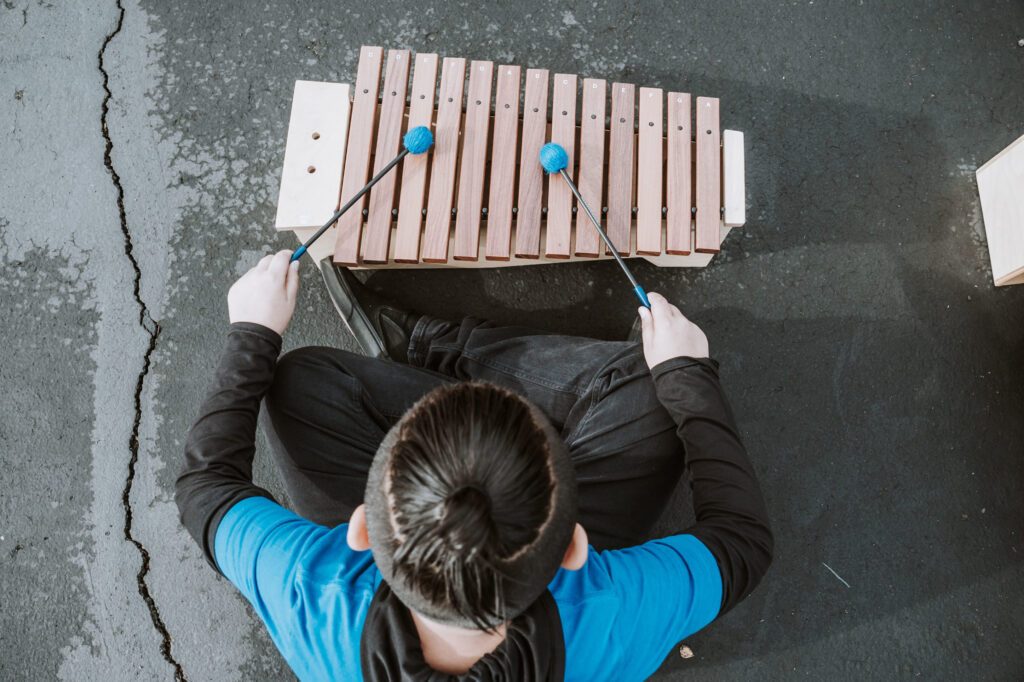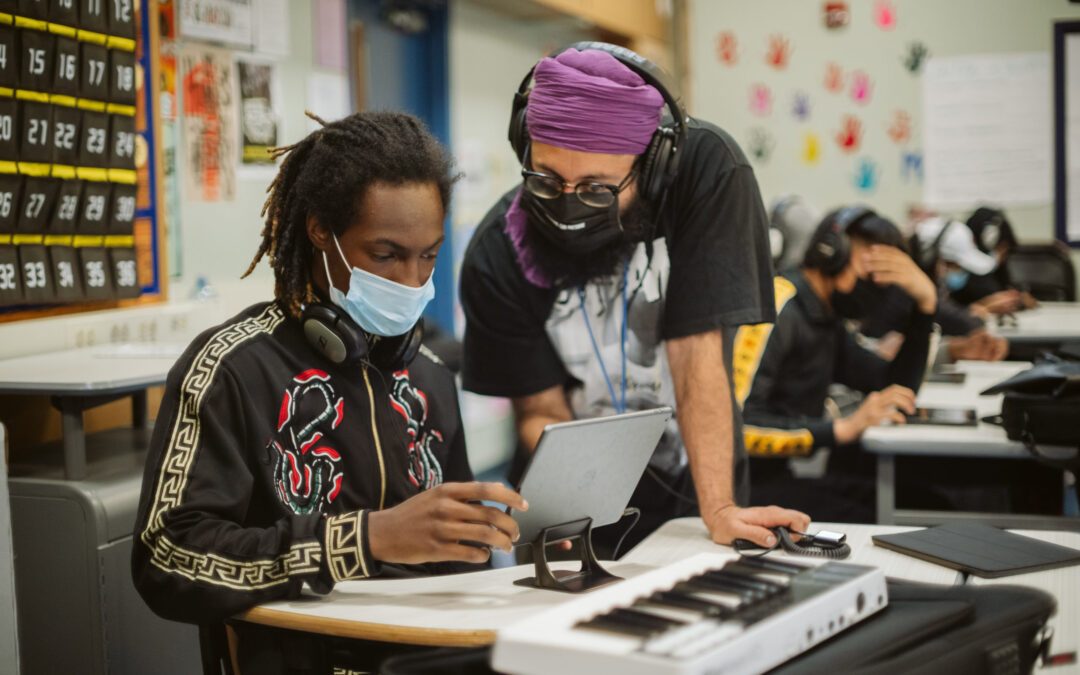Summary
Over the past five years, Save The Music has grown and scaled our work at the community level, building on the culturally rich foundation of American music.
We build community-level partnerships with local music advocates, educators, artists, and funders in places where we can invest in 30, 50 or 100+ schools over several years – driven by thorough needs assessments from those partners.
When successful, this approach catalyzes growth across a community music ecosystem – creating impact for students, schools, and other arts & music non-profits.
Introduction
On a podcast last year with Joan Garry, social impact guru and author of “Non-Profits Are Messy,” I attempted to lay out Save The Music’s new community-focused strategy. I talked about how we sometimes spend 1-2 years building local educator, partner, and funder relationships, and gathering data about a community before we start investing in school music programs there.
Joan stopped me and said something to the effect of, “One to two years! Why don’t you just send the schools instruments when they ask for them?!”
On what was otherwise an excellent podcast appearance (you can listen to it here and judge for yourself), Joan’s questions tripped me up.
Why focus at the community-level? And how does Save The Music select which communities it invests in?
1) American Communities Are Culturally and Musically Rich
In Save The Music’s experience, most communities are already rich with music. Your neighbors are very likely making music somewhere in your town right now – at home with their children, in church with their fellow congregants, in restaurants and bars, or at community gatherings.
In addition, many American communities are the creators of the popular musical genres that drive music making all around the world. Pop, R&B, hip hop, rock, gospel, and country all have their roots here.
By investing in new music programs in schools in places like New Orleans, Save The Music is building on a solid foundation of cultural and musical history.
When we travel to meet and work with our partners in New Orleans, We’re not there to tell anybody anything about music. New Orleans invented music. And so did Memphis, Mississippi, New York City, Newark, Miami, West Virginia, Ohio, Los Angeles, and many more of our partner communities.
2) The Communities That Created Pop Music Have Been Systemically Disconnected from Music Education
Based on a comprehensive national analysis of the arts and music offerings in American high schools published in 2020, researchers for the National Endowment for the Arts found that the availability of music instruction in schools was significantly linked to:
- Student socioeconomic status – more students on Free/Reduced Lunch correlated to fewer music offerings
- Geography – city and rural school districts offered less music, especially in the Western U.S.
- Demographics of the student body – generally, as the proportion of students of color in a school increased, the likelihood of the school offering music courses decreased
- Non-charter vs. charter schools – charter schools were significantly less likely to offer music programs.
Based on the above, Save The Music estimates that at least 4 million students across the U.S. do not have access to music education as part of their school day. This gap is most pronounced among students of color attending school in a city or rural school district.
At the same time, young people and musicians in cities and rural areas are the same communities that created the American popular music genres that inspire people around the world.
3) We Can Target Our Investments to Where They Have the Community Impact
To maximize our impact and invest in the places here we can invest in 30, 50 or 100+ schools in a specific place – catalyzing growth across its entire community ecosystem.
Save The Music defines “community” here relatively broadly. A Save The Music community can be a single city school district (e.g. LAUSD or Miami-Dade, a small set of school districts in and around a city (e.g. Detroit Metro), or a collection of regionally-focused rural school districts (e.g. our projects in West Virginia and Mississippi.)
Then we apply a data-driven rubric – developed in partnership with a pro bono strategy and data team at Morgan Stanley – that looks at four factors:
- Need – Socioeconomic need is the largest determining factor. The model often uses Free and Reduced Lunch as a proxy for the district’s need.
- Demand – Based on 25 years of grantmaking to public school districts, we have identified several factors that signal whether there is community demand for Save The Music grants. School Superintendents who have some tenure in their district and have made arts & music programs part of their strategic plan are strong positive indicators, as is evidence of past engagement with Save The Music.
- Infrastructure – Save The Music’s program requires a significant commitment from school districts who receive the grant of instruments, equipment, technology, and teacher support. The district hires certified music teachers, schedules music as a regular class and dedicates a room in each school for music. We also look for the presence of a local “champion” in the school administration.
- Funding – Most of Save The Music’s project-level funding comes from funders local to each project. The rubric assesses the opportunity for music education funding from foundations, local corporations and/or government sources.
This approach helps us prioritize the communities with the most need and map the projects on our path to bringing access to music education eventually to every student in every school.
For example, in our Mississippi project we started by connecting to school and community partners across ten counties with need in the Mississippi Delta, where school administrators expressed significant interest in investing in elementary and middle school music instruction. The project then expanded to school districts in adjacent counties with need in North Mississippi, leading to a total of six Mississippi school investments in the 2021-22 school year. Now entering its second year, the project has added a philanthropic partner in East Mississippi and school district partners in Neshoba and Lauderdale Counties.
In each phase, Save The Music prioritized districts with need, connected with school leaders to assess demand and infrastructure for music education in each district, and co-created investment plans with school, community and philanthropic partners.

4) Community Partners Co-Create and Scale Impact Beyond Our Own Program
Centering communities in our work, we can scale our impact beyond individual school grants. Our local partners drive Save The Music’s approach in three ways:
Bringing People Together – In 2018, our partners at Artist Corps NOLA and Preservation Hall helped us bring together over 150 community music leaders – including educators, school and district administrators, foundations, city leaders and cultural institutions. Together we put together a plan, now heading into its fourth year, to jump start new music programs in 40 Orleans Parish schools.
Co-Creating the Plan – In all our programs – local partners set the direction for what programs go into which schools – whether it’s elementary music; middle school band, strings, mariachi, or music technology; or our J Dilla Music Tech grant for high schools.
Local champions can differ by program. Often arts leaders in the school district take the lead. Visual and performing arts coordinators in Newark and Los Angeles have been essential to the growth and success of those projects. School superintendents in Dayton Ohio and Watsonville California have strongly committed to music education as part of the plan for their districts. In West Virginia, the Governor’s office has helped us invest in over 100 schools there. In Mississippi our champion is a small non-profit with a dynamic leader, Successful Inc. and Erskin Mitchell.
In each case, Save The Music’s role is to bring our expertise and ability to match funders with local public school districts – then empower local leaders to inform the details of those investments.
Sustaining Impact – Save The Music’s contributions over the life of these community projects are largely one-time, upfront capital investments to get new music programs started. We rely on our school district partners to commit to the teacher, class time and building space for at least ten years to receive the grant.
Over the past twenty-years we’ve found this to be a very sustainable model for school music programs. Over 95% of the more than 600 schools we’ve supported in the past ten years still have active music education offerings.
Just as importantly, we hope that by investing in the widest possible access to music and bringing together local partners, Save The Music is catalyzing growth across the community music ecosystem.
Conclusion
Save The Music’s mission is helping students, schools and communities reach their full potential through the power of making music. Think of the students and schools at the base of that community pyramid.
When more students have music education access, more of them then find their way to after-school programs, community music non-profits, higher education in music, music careers and other parts of the music-making ecosystem.
And when young people are making music, we know that they do better, their schools do better and the community does better, as we continue to invest in and build the rich and influential history of American music.

